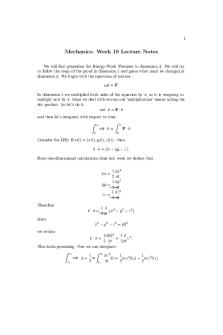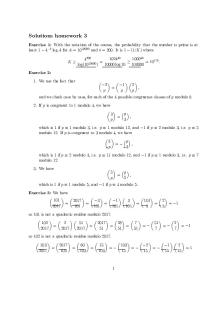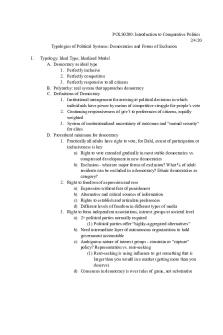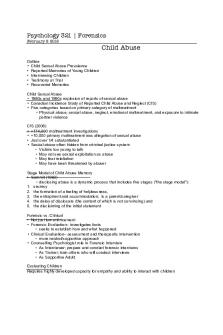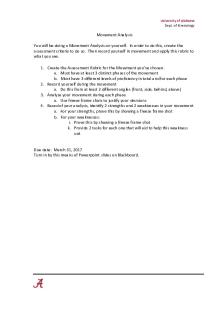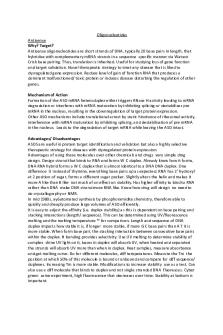Tutorial Notes - Taught by Andrew Eberhard PDF

| Title | Tutorial Notes - Taught by Andrew Eberhard |
|---|---|
| Course | Information Systems |
| Institution | University of Auckland |
| Pages | 9 |
| File Size | 627.4 KB |
| File Type | |
| Total Downloads | 83 |
| Total Views | 138 |
Summary
Taught by Andrew Eberhard...
Description
Identifying Problems & Recommendations Problem Identifying a problem Remember theme of assignment Make sure you have sufficient evidence/research Make sure problem is not too huge Make a list of all possible problems- must be existing, not possible/imagined/future The difference between symptoms, a core problem and causes Symptoms - indicators of the problem Core problem - the problem Causes - why is this happening? Drawing a problem tree A problem tree provides an overview of all the known causes and effects/symptoms to an identified problem 1. Group all the problems into categories 2. For one category, identify a core problem (may involve trial & error) 3. Determine which problems are "Causes" and which are "Effects/Symptoms" 4. Arrange in hierarchy both Causes and Effects
Roots = root cause of all problems Trunk = core problem Leaves = symptoms are what you see on surface
Assessing and justifying a problem (width and depth) Is there ENOUGH INFORMATION on this problem? Credible sources - news articles, government reports, statistical reports How IMPORTANT is the problem? o Width - How many people it affects o Depth - How severe is the problem if left unaddressed Problem needs to affect a large amount of people and be severe enough to need to be fixed Must fit one category
Conclusion Summarise core problem identified (provide references) Draw a problem tree showing all related causes & symptoms of problem
Discuss the width & depth of problem (provide references) Outline a category of UN's Global Goals for Sustainable Development
Recommendations Brainstorming and assessing potential solutions for a problem List down solutions for core problem identified - solution should use some form of data capture and process that data to provide information Think about which of the causes identified it addresses, a good solution addresses the key causes to that problem List down existing solutions to the problem identified Think about improvements to these existing solutions- adding the IS/IT component or possibly combining some of the existing solutions List pros & cons for shortlisted solutions, deciding BEST solution
Realising the Solution: Vision to Strategy Vision Statement
Think about what you would like to achieve E.g. Apple: "To organize the world's information and make it universally accessible and useful" One sentence, very descriptive, sometimes does not need a time frame It will inspire employees, customers, suppliers & society Clear, visible, passionate Compelling, high level, concise, measurable (KPI) Where is the organisation headed? Future casting
Industry Analysis
Helps organisation understand where/how they fit in the market What sort of business are out there that are already similar & how are they going to thrive? Porter's five forces Industry - important to get industry name correct- not too broad, specific and easy for someone to understand Suppliers - suppliers for entire industry, how much bargaining power do suppliers have? Buyers - different buyers in the industry, how much bargaining power do buyers have? Many substitutes? Threat of new entrants - how easy is it to set up a new business in the industry & compete against everyone else? Set up costs, buying supplies, skill etc. Threat of substitutes - options outside the industry Rivalry among existing competitors - who are you competing against that already exists? Dynamics, competition & products that are supplied inside the industry To understand how to thrive in an industry, you must do an overall analysis of all the five forces and come up with a strategy based on that
Customer Needs
Who are your customers? o Whoever pays for your product o Age, gender, income level etc. o End users are not customers, they are the users of the products/services but do not pay for it What are the customers' needs? o Characteristics/features/functions of the product that the customer would look for o E.g. cheap, quality, reliable etc.
Products & Services
What products/services does your business offer to fulfil these needs? o Specific functions/features/nature of product & how they cater to/align with the identified needs of customers
Suppliers & Partners
Suppliers o Provide raw materials or services that go towards the creation of your final product/service o A business pays suppliers for raw materials/services Partners o Have a mutually beneficial relationship with an organisation o E.g. endorsements from other organisations o Sometimes, suppliers are also partners o A guarantee/promise that the business will not partner with another business
Strategy
A strategy for your business- How will your business operate? How will it compete/thrive in this market? Up-down: competitive scope- product caters to a narrow or broad market? Left-right: competitive advantage- low cost relative to other products or differentiated qualityv product for a premium price?
Realising the Solution: Processes
Identifying Key Value Chain Activities Porter's Value Chain Model
The value chain model illustrates a series of activities and processes, each of which adds value to the product/service Activities = adds value to your g/s Look at the vision & determine the strategy From this, find which activity the business should put most of its efforts into in order to add the most value to their g/s
From Value Chain to Business Processes
Once an organisation has identified it's key value chain activity, they need to establish what the specific processes are within that key value chain activity What processes to focus on & understand to add the most value to the business?
Business Process
A business process is a collection of interrelated tasks, initiated in response to an event, that achieves a specific result for the customer of the process So, within each specific business process, there is a number of steps involved in making the process work
Business Process Modelling A business process model is a graphic representation of the steps in a process, showing the sequence of process tasks Basic Model START/DONE (rounded rectangle) = terminator, at the start & end of every process, possible for multiple endings STEPS (in rectangle) DECISION? (diamond) = a scenario in the business process with a yes/no decision or options to be made
Realising the Solution: Systems System Functionality
Anything a system can do i.e. what activities does it support? What you do with a feature is a functionality Starts with a verb The key to identifying & understanding systems
Processes to Systems
Identify the functionalities a system needs to carry out in order to support a specific process Functionalities are extracted from the steps in a process which lead to the systems needed to support the process
Broad Information Systems
Lef: Executive Information, Decision Support, Transaction Processing, Collaboration Across: Supply Chain Management, Enterprise Resource Planning, Customer Relationships Management (Enterprise wide systems) When identifying broad systems: TPS, DSS, CRM and Collaboration can be used in any organisation (large or small) ERP and SCM are more typical of a large organisation as they are expensive All systems overlap & interrelate with one another
Naming Specific Information Systems
Name of systems are generally determined by their functionality (what the system does) and the processes they support A payment processing system supports a payment process o Take the noun relating to the system o Think of what the system will do e.g. processing, analysis, management, planning o Based on this description, you create the system: noun, verb system o E.g. marketing analysis system, inventory management system, order processing system...
Similar Free PDFs

Prob notes - taught by Oliver johnson
- 134 Pages
Popular Institutions
- Tinajero National High School - Annex
- Politeknik Caltex Riau
- Yokohama City University
- SGT University
- University of Al-Qadisiyah
- Divine Word College of Vigan
- Techniek College Rotterdam
- Universidade de Santiago
- Universiti Teknologi MARA Cawangan Johor Kampus Pasir Gudang
- Poltekkes Kemenkes Yogyakarta
- Baguio City National High School
- Colegio san marcos
- preparatoria uno
- Centro de Bachillerato Tecnológico Industrial y de Servicios No. 107
- Dalian Maritime University
- Quang Trung Secondary School
- Colegio Tecnológico en Informática
- Corporación Regional de Educación Superior
- Grupo CEDVA
- Dar Al Uloom University
- Centro de Estudios Preuniversitarios de la Universidad Nacional de Ingeniería
- 上智大学
- Aakash International School, Nuna Majara
- San Felipe Neri Catholic School
- Kang Chiao International School - New Taipei City
- Misamis Occidental National High School
- Institución Educativa Escuela Normal Juan Ladrilleros
- Kolehiyo ng Pantukan
- Batanes State College
- Instituto Continental
- Sekolah Menengah Kejuruan Kesehatan Kaltara (Tarakan)
- Colegio de La Inmaculada Concepcion - Cebu


